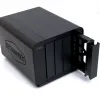Product Gallery
The Terramaster F4-424 Pro NAS symbolises a step forward in the design and functionality of 4-Bay network-attached storage systems, integrating a contemporary chassis and enhanced cooling capabilities. This change marks a noteworthy deviation from its predecessor, the F4-423, by introducing a more accessible and user-friendly layout, particularly in terms of internal component upgrades. The device comes with a 90W power supply unit, aligning with the standard for its class, and is presented in packaging that reflects a careful balance between cost-effectiveness and functionality. Despite some economizations in packaging materials and warranty provisions, the F4-424 Pro maintains a competitive edge through its reasonable pricing and very robust hardware specifications.
You'll notice that the F4-424 Pro has a reimagined structure, which significantly improves upon the ease of access to crucial internal components such as M.2 NVMe slots and RAM modules. This design choice eliminates the need for complete disassembly to reach these components, a noteworthy improvement over the F4-423.
In terms of connectivity, the F4-424 Pro is equipped with dual 2.5GbE network ports, USB 3.2 Gen 2 ports available in both Type-A and Type-C forms, and an HDMI 2.0b port capable of delivering 4K video at 60FPS. Despite these comprehensive connectivity options, the lack of 10GbE support and a PCIe expansion slot might be seen as shortcomings, particularly for a product bearing the 'Pro' moniker and priced similarly to less equipped models.
The design of the system incorporates subtle LEDs that provide visual indicators for storage, system, and network statuses. They're a bit hard to notice though.
The rear panel of the device is equipped with screws that, once removed, reveal the motherboard. This area houses a DDR5 SODIMM slot and a pair of M.2 slots, enhancing the system's upgradability. Although the memory slot arrives with the maximum size module installed, it permits replacement with larger capacities if necessary. However, the physical space above the M.2 slots imposes restrictions on drive compatibility, limiting it to bare NVMe drives and suggesting the use of PCIe 3.0 for optimal bandwidth.
Distinguishing the F4-424 Pro from its standard counterpart, the F4-424, and its forerunner, the F4-423, is its usage of the N300 processor. This choice delivers considerable performance enhancements, primarily due to the processor's advanced architecture, which doubles the core count and supports eight threads while simultaneously reducing power demands. The N300 operates with a Thermal Design Power (TDP) of a mere 7 watts, a stark contrast to the 15 watts required by the N95, despite both chips being produced using Intel's 7 (10nm) fabrication process.
The N300 also boasts a slightly better UHD Graphics GPU, contributing to its overall efficiency and capability. But as you can see, the SoC clearly likes a bit of cooling real-estate, a heatsink is covering most of the SoC side of the PCB, with the fan in the rear blowing cool are over it :)
Both the N300 and N95 processors are limited by their support for only a modest number of PCIe lanes (nine in total for everything) and a single memory channel. However, they accommodate various memory standards, including DDR4, DDR5, and LPDDR5, with the latter offering a significant boost in channel bandwidth that positively impacts both the CPU and GPU's performance. The constraint imposed by the limited number of PCIe lanes poses certain challenges, particularly in terms of expanding the device's connectivity features, such as additional M.2 slots, USB ports, and LAN connections. Although integrating a two-lane PCIe slot could potentially mitigate some of these restrictions, it would inevitably lead to compromises in other system components. Overall we're okay with the design choices made here as you do get 2x M2 slots running PCe Gen 3.0.









